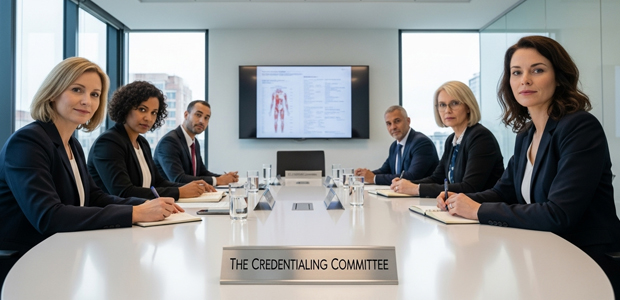Healthcare credentialing is the foundation that keeps patients safe and ensures every provider in your facility meets the qualifications needed to deliver quality care. When credentialing works well, patients receive care from verified, qualified professionals. When it doesn’t work well, you face revenue delays, frustrated providers, and potential risks to patient safety.
 If you’ve ever dealt with lost documents, endless email chains about missing information, or delays that keep qualified providers from seeing patients, you know exactly what we’re talking about. These problems aren’t just annoying. They hurt your organization in real ways.
If you’ve ever dealt with lost documents, endless email chains about missing information, or delays that keep qualified providers from seeing patients, you know exactly what we’re talking about. These problems aren’t just annoying. They hurt your organization in real ways.
Consider these facts about what happens when credentialing falls behind. About 60% of healthcare organizations report revenue delays of 90 days or longer because of credentialing bottlenecks. The average revenue loss per provider per month due to these delays hits $7,500. Provider turnover increases by 25% when credentialing processes frustrate new hires. 40% of credentialing committees report compliance violations because they’re still using manual processes that lead to errors.
This guide breaks down how credentialing committees work and shows you how to build a system that’s faster, more accurate, and easier for everyone involved. You’ll learn about the key pieces that make credentialing work, how to set up an effective committee, and ways to streamline your workflow so providers can start seeing patients sooner.
What Makes Credentialing Work: The Essential Building Blocks
Before diving into committee structure and meetings, let’s look at the core components that every credentialing process needs to include.
Primary Source Verification
Primary source verification means checking a practitioner’s qualifications directly with the original source. Instead of accepting a copy of a medical degree, you contact the medical school to confirm the degree was actually granted. Instead of taking someone’s word about their board certification, you verify it with the certifying board itself. This step catches errors and prevents fraud, but it also takes time when done manually.
Peer Review Process
Peer reviews let medical professionals evaluate each other’s work. When a new cardiologist joins your hospital, other cardiologists can assess their procedural success rates, patient outcomes, and professional conduct. This helps ensure that everyone practicing in your facility meets the standards your organization requires. Peer review is about maintaining quality and helping providers improve where needed.
Performance Evaluation
Credentialing doesn’t stop once someone joins your staff. Ongoing performance evaluations ensure that practitioners continue meeting quality benchmarks throughout their tenure. These evaluations might look at patient outcomes, adherence to protocols, participation in continuing education, and other factors that indicate a provider maintains their skills and knowledge.
Regulatory Compliance
Healthcare operates under strict regulations at both national and local levels. Your credentialing process must comply with requirements from Medicare, Medicaid, state licensing boards, and accrediting organizations. Failing to meet these standards can result in penalties, loss of accreditation, or suspension of billing privileges. The rules change frequently, so staying current requires ongoing attention.
The People Behind the Process: Key Stakeholders
 Credentialing involves several groups working together, each with specific roles.
Credentialing involves several groups working together, each with specific roles.
Medical staff services teams handle the administrative work, collecting documents, organizing files, and ensuring applications are complete before they reach the committee. Healthcare administrators make sure credentialing aligns with the organization’s broader goals and strategic plans. The practitioners themselves, including physicians, nurses, and other providers, are obviously central to the process since their qualifications are being verified.
Quality management teams monitor how well the credentialing process works and look for ways to improve it. And committee members review all this information to make decisions about who gets privileges and what scope of practice each provider receives.
When these groups communicate well and everyone knows their role, credentialing moves smoothly. When communication breaks down or responsibilities aren’t clear, applications sit in limbo and everyone gets frustrated.
Building Your Credentialing Committee: Structure and Selection
The right committee structure makes everything else easier. Here’s how to set up a credentialing committee that actually works.
Getting the Size Right
Committee size matters more than you might think. Too small and you don’t have enough expertise or perspective. Too large and meetings become unwieldy, making decisions takes forever, and scheduling becomes impossible. For facilities under 200 beds, aim for 7 to 9 members. Larger institutions typically need 11 to 13 members to represent different specialties and perspectives adequately.
Defining Clear Roles
Every committee member should have a defined role. The chairperson leads meetings, keeps discussions on track, and ensures decisions get made. The recorder documents everything accurately, creating minutes that serve as official records. Peer reviewers bring specialty-specific expertise to evaluate applications in their fields. When everyone knows what they’re responsible for, meetings run more efficiently and nothing falls through the cracks.
Planning for Turnover
Set term limits for committee members, typically two to three years. This brings fresh perspectives into the process and prevents burnout. But you also need succession planning so experienced members can mentor newer ones before leaving. The transition between old and new committee members shouldn’t create knowledge gaps that slow everything down.
Selecting the Right People
Committee members need specific qualifications. They should know credentialing requirements, regulatory standards, and quality assurance principles. Choose people who can evaluate credentials objectively and make sound decisions under pressure. Include physicians from various specialties so you have relevant expertise when reviewing applications from different fields.
Training and Ongoing Education
New committee members need thorough orientation covering your organization’s policies, credentialing workflows, and decision-making frameworks. Don’t just hand them a manual and wish them luck. Walk them through actual cases and explain how decisions are made and documented.
Schedule regular training sessions to keep all members updated on changes in healthcare laws, new technologies, and emerging best practices. The regulatory landscape shifts constantly, and your committee needs to stay informed.
Managing Conflicts of Interest
Establish clear protocols for handling conflicts of interest. If a committee member knows an applicant personally or has a professional relationship with them, they should recuse themselves from reviewing that application. Document these recusals to demonstrate your process remains fair and objective.
Streamlining Your Workflow: Before, During, and After Meetings
How you structure your workflow determines how quickly and accurately credentials get processed.
Pre-Meeting Preparation
 Review practitioner files thoroughly before meetings to ensure all necessary documents are included. Missing items should be identified early so staff can request them before the meeting, not during it.
Review practitioner files thoroughly before meetings to ensure all necessary documents are included. Missing items should be identified early so staff can request them before the meeting, not during it.
Use standardized templates for resumes, licenses, and certifications. When everyone submits information in the same format, reviewing files becomes faster and comparing qualifications becomes easier. You spend less time hunting for information and more time actually evaluating credentials.
Identify red flags during the pre-meeting review. Look for gaps in employment history, malpractice claims, disciplinary actions, or other issues requiring further investigation. Flag these items so the committee can discuss them during the meeting rather than discovering them for the first time during presentations.
Digital tools can automate much of this work. Modern credentialing software can pull data automatically, track documents, and alert staff to missing items or upcoming deadlines. This reduces the manual labor involved in file preparation and minimizes human error.
Running Effective Meetings
Start each meeting with a clear agenda that prioritizes critical files. Applications with urgent timelines or flagged concerns should come first. Assign time slots to each agenda item to keep discussions moving without rushing important decisions or letting less critical items dominate the meeting.
Present files using standardized templates that outline key information at a glance. A file for a new surgeon might show their medical school, residency program, board certifications, procedure volumes, success rates, and any malpractice history. This format lets committee members quickly grasp the essential facts without wading through pages of documents.
Use a consistent decision-making framework. Whether you vote or reach decisions by consensus, the process should be the same for every application. This ensures fairness and makes it easier for new committee members to participate effectively.
Document everything. Meeting minutes should capture key discussions, decisions made, and the reasoning behind those decisions. These records protect your organization during audits or legal challenges. They also provide a reference when similar cases arise in the future.
Post-Meeting Actions
 Notify providers promptly about decisions. If an application is approved, let them know right away so they can start seeing patients. If it’s conditionally approved, explain clearly what additional steps are required. If it’s denied, provide detailed feedback and information about the appeals process.
Notify providers promptly about decisions. If an application is approved, let them know right away so they can start seeing patients. If it’s conditionally approved, explain clearly what additional steps are required. If it’s denied, provide detailed feedback and information about the appeals process.
For conditional approvals, establish clear follow-up procedures. If a physician needs to submit an updated license, assign a specific deadline and track progress. Don’t let conditional approvals languish indefinitely because no one followed up.
Create a clear appeals process that gives practitioners a fair opportunity to challenge decisions. They should be able to submit additional evidence or request a formal hearing. Having this process in place protects both the practitioner’s rights and your organization from legal risks.
Maintain all records in a secure system that’s also easily accessible when needed. This includes meeting minutes, practitioner files, and all communication logs. During audits or legal inquiries, you need to produce these documents quickly.
Managing Risks and Maintaining Quality
Credentialing directly affects patient safety and your organization’s financial health. Poor credentialing can lead to malpractice cases, regulatory penalties, and revenue loss.
The financial risks are substantial. The average malpractice settlement involving credentialing oversight runs around $500,000. Regulatory fines for compliance gaps typically range from $50,000 to $100,000. If Medicare billing privileges are suspended due to credentialing issues, you could lose $10,000 or more per day until the problem is resolved.
Legal Considerations
 Stay current with regulatory requirements from Medicare, Medicaid, and state licensing boards. These rules change frequently, and ignorance isn’t a defense if you violate them. Assign someone to monitor regulatory updates and brief the committee on changes that affect your processes.
Stay current with regulatory requirements from Medicare, Medicaid, and state licensing boards. These rules change frequently, and ignorance isn’t a defense if you violate them. Assign someone to monitor regulatory updates and brief the committee on changes that affect your processes.
Implement fair hearing procedures to protect practitioners’ rights. If you deny privileges or restrict a provider’s scope of practice, they deserve a chance to respond and present their case. Following proper procedures protects your organization from legal challenges.
Document your rationale for every decision. If a surgeon’s privileges are denied due to performance concerns, the records should clearly show what those concerns were, what evidence supported them, and why the committee felt denial was appropriate. Thorough documentation demonstrates that decisions were made objectively based on facts, not bias or personal conflicts.
Protect confidentiality at all times. Credentialing files contain sensitive information about practitioners’ education, work history, and any past disciplinary actions. Limit access to authorized personnel only and use secure systems for file storage and transmission.
Tracking Quality Metrics
Measure your credentialing performance with specific metrics. Track how long it takes to process initial applications, re-credentialing, and expedited cases. Monitor your error rate to see how often files need corrections. Survey practitioners about their satisfaction with the credentialing process. Check compliance rates to ensure you’re meeting all regulatory requirements.
Set clear turnaround time standards. For routine applications, aim to complete the process within 90 to 120 days. Expedited cases should move faster, potentially within 30 to 45 days. When you establish clear timelines, everyone knows what to expect and delays become more visible.
Use audits, scorecards, and other quality assessment tools to evaluate how well your credentialing process works. Look for bottlenecks, recurring problems, and opportunities for improvement. Regular assessments help you catch small issues before they become big problems.
Continuous Improvement Strategies
 Don’t let your credentialing process stagnate. Review procedures regularly to identify inefficiencies. Update policies to reflect regulatory changes and lessons learned from past cases. Provide ongoing training for staff and committee members to keep skills sharp and knowledge current.
Don’t let your credentialing process stagnate. Review procedures regularly to identify inefficiencies. Update policies to reflect regulatory changes and lessons learned from past cases. Provide ongoing training for staff and committee members to keep skills sharp and knowledge current.
Adopt new technologies that can streamline your workflow. Modern credentialing software can automate repetitive tasks, track documents automatically, and alert staff to deadlines. These tools don’t replace human judgment, but they do eliminate much of the tedious manual work that slows down credentialing.
Create feedback loops so everyone involved in credentialing can suggest improvements. Staff members who work with the system daily often spot problems and solutions that committee members might miss. Practitioners going through credentialing can provide valuable perspective on what’s confusing or frustrating about the process.
Using Technology to Speed Things Up
Technology can transform credentialing from a slow, paper-heavy process to a streamlined digital workflow.
Credentialing Software
 Modern credentialing platforms centralize all your data in one place. Instead of hunting through filing cabinets or multiple computer systems, everything is in a single database. Staff can pull up any provider’s file instantly, check the status of applications, and see what documents are still needed.
Modern credentialing platforms centralize all your data in one place. Instead of hunting through filing cabinets or multiple computer systems, everything is in a single database. Staff can pull up any provider’s file instantly, check the status of applications, and see what documents are still needed.
These platforms automate primary source verification, which is one of the most time-consuming parts of credentialing. Instead of staff members calling medical schools, licensing boards, and certifying organizations individually, the software can verify credentials electronically in minutes or hours rather than weeks.
Look for software that integrates with your existing HR, payroll, and compliance systems. When data flows seamlessly between systems, you avoid duplicate data entry and reduce errors. Integration might mean that once someone is credentialed, they’re automatically added to the scheduling system and payroll without anyone manually entering their information again.
Automation Opportunities
Automate application processing by using digital forms that practitioners complete online. Build validation into these forms so they can’t be submitted incomplete. If a required field is empty or a date doesn’t make sense, the system prompts the applicant to fix it before submission.
Automate license and certification expiration tracking. The system should flag licenses expiring in the next 60 or 90 days and send automatic reminders to both the provider and credentialing staff. This prevents compliance lapses that could force a provider to stop seeing patients until their credentials are updated.
Generate reports automatically to evaluate credentialing performance. Instead of manually compiling statistics about average processing times or compliance rates, the system can produce these reports on demand or on a regular schedule. This data helps identify trends and measure the impact of process improvements.
Data Security
 With sensitive practitioner information stored digitally, security becomes critical. Choose credentialing software with robust encryption for data at rest and in transit. Implement strict access controls so only authorized users can view credentialing files. Use audit logs that track who accessed what information and when, creating accountability and helping detect unauthorized access.
With sensitive practitioner information stored digitally, security becomes critical. Choose credentialing software with robust encryption for data at rest and in transit. Implement strict access controls so only authorized users can view credentialing files. Use audit logs that track who accessed what information and when, creating accountability and helping detect unauthorized access.
Regular security audits should verify that your systems remain protected against evolving threats. Back-up data regularly and test your ability to restore from backups in case of system failure or cyberattack.
Handling Special Situations
Standard credentialing processes work for most situations, but some cases require special approaches.
Temporary Privileges
 Sometimes you need to grant privileges quickly. During natural disasters, disease outbreaks, or other emergencies, you might need out-of-state physicians immediately. Locum tenens providers filling in for vacationing staff also need faster credentialing.
Sometimes you need to grant privileges quickly. During natural disasters, disease outbreaks, or other emergencies, you might need out-of-state physicians immediately. Locum tenens providers filling in for vacationing staff also need faster credentialing.
Develop streamlined processes for these situations that maintain safety without the full timeline of standard credentialing. You might grant temporary privileges based on verification from another facility where the provider already has credentials, with the full credentialing process completed within a specific timeframe, typically 60 to 90 days.
Document clearly that these are temporary privileges, what conditions apply, and when the provider must complete full credentialing. This protects your organization while allowing you to respond to urgent staffing needs.
Focused Professional Practice Evaluation
Focused Professional Practice Evaluation, or FPPE, happens when concerns arise about a provider’s competence. Perhaps there’s been a patient complaint, an unexpected outcome, or a pattern that suggests performance issues.
Create clear monitoring plans with specific assessment criteria. If a surgeon is under FPPE, you might monitor their next 10 procedures, review all their patient outcomes for three months, or have another surgeon directly observe their work. The monitoring plan should be objective and specific enough that everyone knows what’s being evaluated and what standards apply.
After the monitoring period, conduct a formal review to determine next steps. The provider might simply return to regular practice, might need additional training or supervision, or in serious cases, might have privileges restricted or removed. Document everything thoroughly because FPPE cases sometimes lead to legal challenges.
Measuring Your Progress
 You can’t improve what you don’t measure. Establish clear metrics for your credentialing process and track them consistently.
You can’t improve what you don’t measure. Establish clear metrics for your credentialing process and track them consistently.
Start with basic measurements like how long applications take from submission to final approval. Break this down by type of application since initial credentialing typically takes longer than recredentialing. Track how many applications require additional information or corrections, which indicates problems with your forms or instructions.
Survey practitioners about their credentialing experience. Ask what was confusing, what took too long, and what could be improved. They’re going through your process firsthand and can provide insights you won’t get from internal metrics alone.
Conduct regular audits to verify compliance with your policies and regulatory requirements. Pull random samples of credentialing files and review them against your checklist. Do files contain all required documents? Were verifications completed properly? Are signatures and dates in the right places? These audits catch problems before external auditors or accrediting bodies find them.
Review and update your policies regularly. When regulations change, update your procedures to match. When audits reveal problems, revise policies to prevent recurrence. When staff suggests improvements, evaluate them and implement ones that make sense.
Provide ongoing training that addresses gaps identified through audits, quality metrics, or feedback. If several staff members are making the same error, that’s a training opportunity. If committee members seem unclear about how to handle certain situations, schedule training on those topics.
Summary: Making Credentialing Work for Your Organization
 Credentialing protects patients by ensuring every provider in your facility is qualified and competent. But it also affects your organization’s finances, your ability to recruit and retain providers, and your compliance with regulations. When credentialing works well, qualified providers start seeing patients quickly, revenue flows in without delays, and everyone stays compliant. When it doesn’t work well, you lose money, frustrate providers, and risk penalties.
Credentialing protects patients by ensuring every provider in your facility is qualified and competent. But it also affects your organization’s finances, your ability to recruit and retain providers, and your compliance with regulations. When credentialing works well, qualified providers start seeing patients quickly, revenue flows in without delays, and everyone stays compliant. When it doesn’t work well, you lose money, frustrate providers, and risk penalties.
The key to effective credentialing is building a solid foundation with clear processes, using the right technology to automate tedious tasks, and continuously measuring and improving your performance. A well-structured credentialing committee with clear roles and consistent procedures ensures applications move smoothly from submission to approval.
At Medwave, we specialize in credentialing along with medical billing and payer contracting. We know how important it is to get providers credentialed quickly and correctly because delays don’t just frustrate people, they cost money. Whether you need help setting up credentialing processes, managing ongoing credentialing for your staff, or handling the entire revenue cycle, we have the expertise and technology to make it happen efficiently.
Medical credentialing keeps changing as regulations shift, technologies advance, and patient care models transform. Organizations that adapt their credentialing processes to these changes maintain smooth operations. Those that stick with outdated manual processes fall further behind, facing longer delays, more errors, and increasing compliance risks.
Take a close look at your current credentialing process. Where are the bottlenecks? What frustrates your staff and your providers? What tasks could be automated? What metrics are you tracking, and what do they tell you about your performance? The answers to these questions will show you where to focus your improvement efforts.
Credentialing is central to your mission of providing safe, quality patient care. Every provider you credential represents dozens or hundreds of patients who will receive care. Getting credentialing right means those patients can trust they’re in qualified, competent hands. That’s worth the effort to build and maintain an excellent credentialing process.

